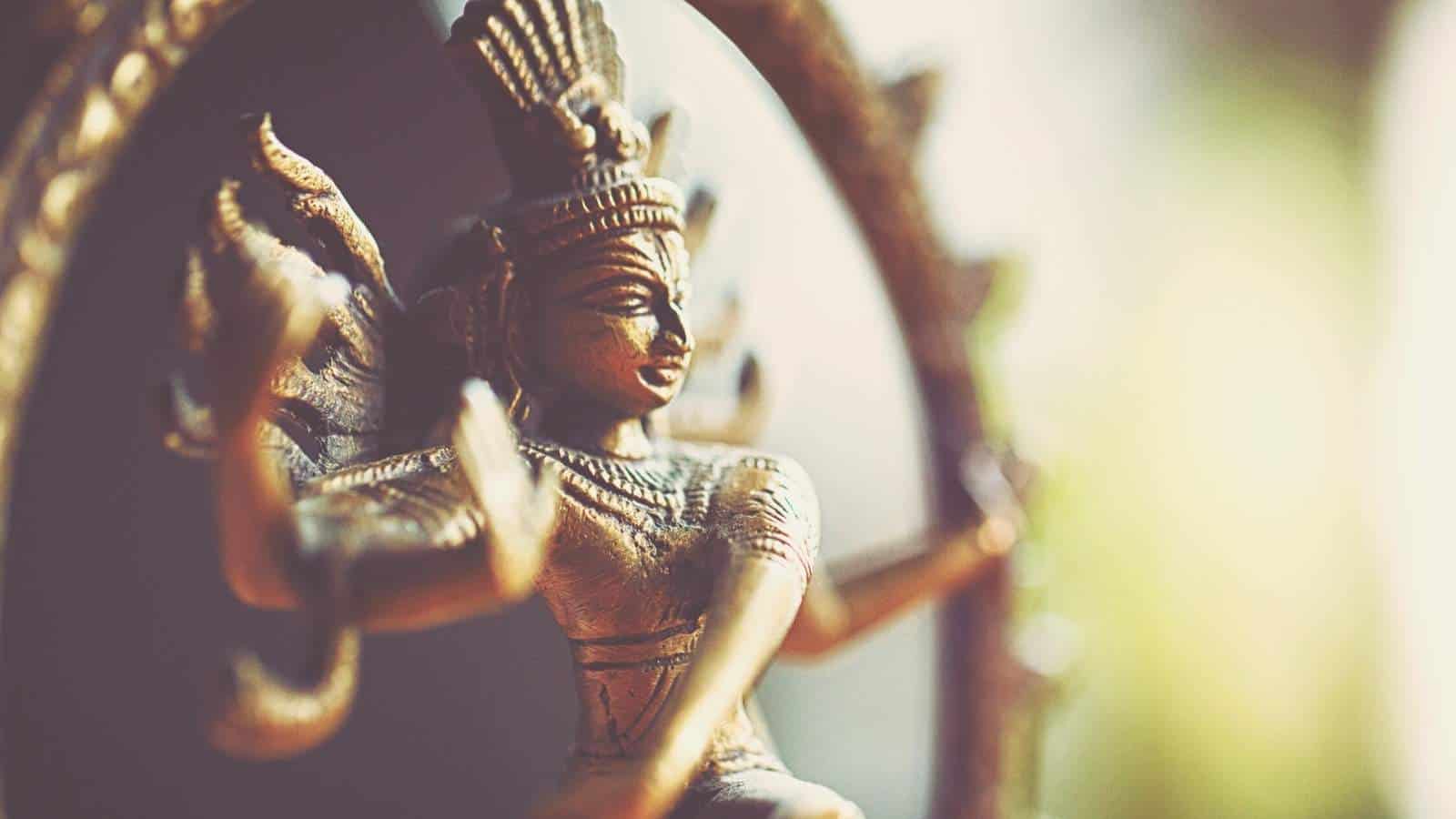Nowadays, yoga is much more accepted than 10 or 20 years ago. In fact, yoga classes can now be found in every corner of the world. Even so, some people still have concerns about the intention of yoga as the practice originated in India and has Hindu roots.
If you follow a religion other than Hinduism, you might wonder if practicing yoga goes against your religion. Likewise, if you’re an atheist, you may worry that incorporating yoga into your life makes you a religious person.
Yoga shares similarities with Hinduism and Buddhism, but it is not a religious activity. Modern yoga may use Sanskrit words or the prayer mudra, but doing yoga poses does not mean you worship god unless you make that your intention.
Read on to learn why yoga is sometimes misinterpreted as a worship practice and where those myths come from.
Yoga Unites The Body, Mind, And Soul
Yoga is a Sanskrit word that means ‘to yoke’ together or ‘unite’ something. Yoga poses create a union between the mind, body, and soul, cultivating balance and harmony in our physical, mental, and emotional bodies.
There are many reasons why yoga is essential in modern life. For example, yoga has the power to improve health conditions, heal ailments, or reduce stress and anxiety and is often recommended by medical practitioners for these reasons.
However, the union we create through yoga extends far beyond ourselves, which can make it a spiritual practice for some people. Yoga helps us expand our consciousness to a point where we experience the ‘ultimate reality or ‘enlightenment.’ It is said that when we reach this state, we see the cosmos and all living things as one, pulsating in this infinite universe.
So while yoga postures help improve your physical, mental, and spiritual health, the practice can allow you to experience the interconnectedness between living things.
Why Yoga Is Mistaken For Worship
Understandably, many people (especially in the West) assume that yoga classes that use Sanskrit words or some brief chanting have a religious aspect. There are quite a few reasons to support such an assumption.
Yoga can begin with a small prayer
The mantra ” Om ” is the most commonly used chant to open a yoga class. Om is known as the universal sound and is considered sacred in the Hindu religion. However, including a prayer or chant in yoga does not mean you worship gods. Instead, it is used to help settle the mind and focus on your intention for the practice.
Some yoga postures involve the prayer position
Along with chanting, yogis start a Sun Salutation flow with Pranamasana posture, which literally means a “prayer posture.” Many other yoga poses, such as Urdhva Hastasana (upward hands pose), Utkatasana (chair pose), or Vrikshasana (tree pose), can also involve joining your palms and raising them to the sky, which may be misunderstood as worship.
However, asanas with prayer positions can be used to express respect for the ancient practice, focus the mind, or simply work on a particular part of the body.
Yoga uses Sanskrit words
Sanskrit is an ancient and classical language of India. It doesn’t directly relate to Hinduism, but Sanskrit is the mother of many Indian languages, including Hindi. There are some similarities between Sanskrit and Hindi found in scripts, words, and pronunciation, but there are also many differences.
Sanskrit is used in yoga classes to stay true to its ancient Indian roots and because it is believed that the vibration of some Sanskrit words can have a powerful effect on your being. A familiar Sanskrit chant used to close a yoga class is “Om Shanti, Shanti, Shanti.”
Shanti means “peace,” so chanting this at the end of a session invokes peace. You can visualize yourself, a loved one, or the entire world when sending the waves of harmony. The effect is as powerful as in Metta (loving-kindness) meditation.
A few yoga poses are named after Hindu Gods
There are 84 fundamental yoga poses, but up to 169 asanas are known and practiced throughout the many different yoga styles. However, out of all these postures, only a few have the names of Hindu Gods.
Most other yoga pose names refer to Lords, Warriors, objects, and animals. Therefore, it’s crucial to note that while some poses are named after Gods, most are not.
For example, the name Bhujangasana (cobra pose) comes from how we lift our upper back and torso off the mat in the asana. It resembles a cobra snake rearing its head, ready to strike. Likewise, Vrikshasana (tree pose) gets its name because of its static nature, solid form, and qualities of a tree-like tranquillity.
Which Yoga Poses Are Named After Hindu Gods?
The origin of yoga poses can be traced back to 2,700 B.C., which was before Hinduism. The original yogic texts like The Vedas did not mention any yoga poses carrying names of gods. Interestingly, it was not until the early 20th century that a few yoga books referred to specific asanas as names of deities (not even Gods).
So, if practicing yoga does not mean worshipping Gods, why were some poses named after them? Many are named after a particular God because of how they looked, behaved, or what they stood for, not to worship them. By calling a pose after a god who carries positive qualities, you can practice it to take on some of their traits, such as selflessness and strength.
Let’s look at some poses named after specific Hindu deities and discuss what that may mean.
Natarajasana

The God Shiva is also known as ‘Natraj,’ meaning the ‘King of Dance.’ Shiva is revered as the god who represents the dance of the cosmos, with all its fluctuations. However, the pose Natarajasana was not created to worship Shiva. Instead, it got its name from a pose in the classical Indian dance form Bharatnatyam, depicted in temple statues in the Nataraja Temple, Chidambaram.
Natarajasana is called “dancer’s pose” as it involves maintaining your outer and inner balance. The tricky balancing position requires keeping your mind still while the body and external reality continuously shift. ‘Dance’ is often used as a metaphor for life, and Natarajasana encapsulates the continuous ups and downs we go through in life and how we must hold ourselves steady through them.
Hanumanasana
More popularly known as “the splits,” the Hanumanasana pays tribute to the Hindu god Hanuman, the monkey god, who was incredibly powerful and flexible. Hanuman was Rama’s half-monkey half-man devotee who helped him defeat Ravana, destroy Lanka, and bring back Sita.
Hindi myths state that Hanuman swung from tree to tree through the forest with one leg extended forward and the other backward, resembling the “splits pose.” However, it is worth mentioning that this pose is one of the newer asanas introduced in yoga practice in the 20th century. Therefore, it is not a traditional posture, nor is it mentioned in any old yoga scriptures.
Virabhadrasana
Virabhadra was the son of Lord Shiva and a fierce warrior, always poised and ready for action. There are three variations of the Virabhadrasana pose (warrior 1, 2, and 3), all of which strengthen the arms, legs, chest, and torso while helping to build confidence.
Interestingly, looking into the history of the warrior pose, Virabhadrasana wasn’t created to worship Virabhadra or any other God. Instead, its name was inspired by European gymnastics as it looks similar to some postures in the Niels Bukh gymnastics.
Bhairavasana
Bhairavasana is a very advanced yoga posture taught in the third series of Ashtanga yoga. It is essentially a side plank variation that requires extreme strength and hip flexibility to put one leg behind the head.
Bhairava is one of the incarnations of the Hindu god and destroyer, Shiva. The word Bhairava has many connotations, such as ‘terribly fearsome form,’ which in this context means ‘formidable.’ In English, the pose is called ‘destroyer of the universe pose.’
The posture is pretty strange looking, and it can appear that the leg is chopping off the head. This relates to a Hindu myth involving Shiva, and performing this posture can be considered a reminder to keep the ego in check.
Astavakrasana
Astavakrasana is an advanced arm balance, which some people think is dedicated to the sage Astavakra, the spiritual guru of King Janaka. Astavakra translates as ‘eight bends’ as according to a Hindi myth, Astavakra was born with his body bent in eight directions.
The English name for this pose is Eight-Angle Pose. Like other yoga postures named after gods, it was not practiced in hatha yoga until the 20th century, when it first appeared in the book Light on Yoga. However, it did appear in the 1896 Vyayama Dipika manual of gymnastics, so it seems that the advanced hand balancing asana was adapted from this practice.
Are Sun Salutations An Act Of Worship?

The sun salutations are the most popular yoga flow, practiced in various yoga styles, such as Hatha, Vinyasa, and Ashtanga. In the western world, sun salutations are included at the beginning of the class, serving as a warm-up to open the body for more challenging asanas. As well as building heat in the body, sun salutations are an excellent way to learn how to connect your movement to your breath during yoga practice.
Sun salutations, or Surya Namaskar in Sanskrit, means “to salute the sun.” In ancient Indian tradition, sun salutations were used in a morning ritual to worship the sun. In the Vedas, the sun is seen as a powerful, all-seeing god who observes both good and evil actions.
Some Indian yoga practitioners may still practice sun salutations with this intention. However, performing sun salutations in a yoga class does not mean you worship any god unless you do it with that intent. However, as the sun provides us with a necessary life force, some modern-day yogis may choose to use sun salutations to express gratitude to the sun and mother earth.
Are Hindu Gods Worshipped During Satsangs?
Exchanging Sanskrit words among yogis is very common. For example, “Namaste” is one of the most common Sanskrit words among yoga practitioners, used to greet or thank someone. Another word that you can hear yogis mention is “Satsang.”
A Satsang is a yogic event where people sing bhajans. Satsang means “gathering of like-minded people for the truth,” and bhajan, translated from Hindu, means “to share.” The event is usually open to everyone, not only yogis or people practicing meditation.
The myth that Satsangs are done to worship Gods comes from the fact that the bhajans are sung in the Sanskrit language. The truth is that the power of bhajans lies in the sounds we pronounce while singing but not in the meaning.
Spiritual teacher Sri Sri Ravi Shankar says that you don’t have to know the meaning of the text you sing to reap the benefits. Instead, simply vocalizing these specific sounds will raise the vibrations in your body, calm the wandering mind and bring balance to both hemispheres of the brain.
Some yogis attend Satsangs to progress further down their spiritual path or find deeper understanding. However, many choose to join Satsangs for the calming and mood-boosting benefits.
Yoga Is A Personal Practice
While there are aspects of Hinduism in yoga, and historically, Indian yogis used yoga as a form of worship, it’s important to note that you cannot “accidentally” worship gods by practicing yoga. To worship a god, like to pray, requires intention. So if you are practicing yoga without any purpose of worshiping a god, it is not a religious practice.
People choose to practice yoga for many different reasons. Your intention for your yoga practice could be something physical, mental, spiritual, or a combination, as there is a wide range of benefits that yoga gives.
Therefore, practicing yoga does not mean you are a religious or even a spiritual person. For many people in the western world, yoga is a hobby rather than a spiritual journey. Therefore, anyone can (and should) practice yoga, regardless of religious beliefs.
Final Thoughts
It’s easy to see why some people think that yoga is about worshipping gods or a particular religion. However, while some parts do have a godly aspect, yoga is not a religious practice. The only person you worship through yoga is yourself, as you use the postures to work on improving your health and wellbeing.




